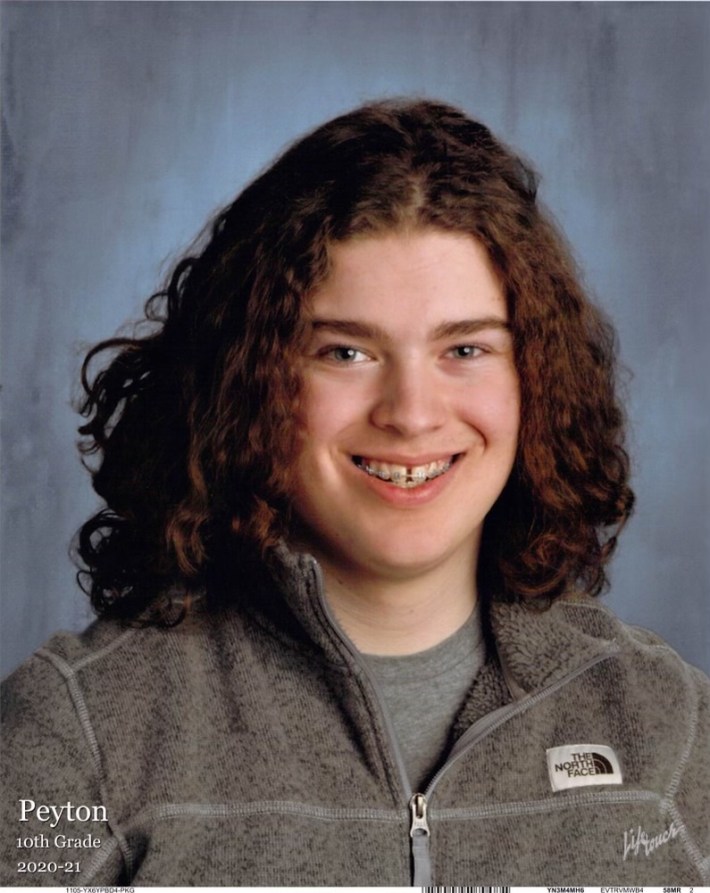Last spring, Michelle Mills saw Maryland State Police Trooper Joseph Azzari shoot and kill 16-year-old Peyton Ham. Mills says for the past seven months, she has only talked to law enforcement officials and God about watching the kid next door die.
But she’s ready now to tell others. And Mills doesn’t describe the loss of life that took place right in front of her in broad daylight as accidental or the result of merely bad police work.
“Peyton was murdered in my driveway,” she says.
Mills, 51, says Ham was kneeling in the gravel and already wounded and bleeding badly when she saw Azzari fire four shots at him. Based on an audio recording of the shooting captured by a nearby security camera system, those were the last four of the 15 bullets Azzari fired at Ham—every single bullet in his Glock 22 service weapon—over a period of one minute and seven seconds. At least three of the final four shots hit Ham in the neck and chest, killing him.
Allison Mills, Michelle's daughter, also saw Azzari kill Ham.
“Peyton was on his knees and obviously wasn’t a threat,” Allison Mills, 23, says of Ham’s final moments. “What I saw, from start to finish, was just appalling.”
At a press conference hours after the shooting, police claimed Ham was shot because he threatened Azzari with a fake handgun and a pocket knife with a three-inch blade. In the hours and days after the killing, lots of TV and newspaper reporters came to Leonardtown, a small (pop: 3,700) and rather isolated town located on a Southern Maryland peninsula where the Potomac River and Severn River dump into the Chesapeake Bay. Michelle Mills says many members of the media knocked on her door to ask what she knew about the boy with a toy gun who got killed on her property, but she wasn't ready to tell them.
Michelle and Allison Mills both say they told police investigators at the scene what they saw, and repeated those accounts later in writing for police reports, in talks with the St. Mary’s County state’s attorney’s office, and while testifying in front of a grand jury. But they declined all media requests, Michelle says, out of a combination of trauma and a desire to not say anything that would upset Ham’s family or hurt the investigation.
The reporters soon stopped calling, and the story of Ham’s killing all but went away. But Mills says her faith that the justice system would properly handle the matter made staying quiet still feel OK. Then on October 20, Richard Fritz, state’s attorney for St. Mary’s County, announced that the investigation of Ham’s killing was closed, and that no charges would be filed against Azzari.
The report explaining the state’s exoneration of the officer said Azzari “was in reasonable fear for his life” and had “acted in lawful self-defense and the defense of others” in killing Ham. Allison Mills finds grotesque and ludicrous the contention that Ham was a threat to Azzari or anybody else. She and her mother both feel the report’s most preposterous portion holds that Ham "stood up and approached Trooper Azzari” with a knife just before getting killed.

Michelle Mills says she knows Ham wasn’t standing when the fatal shots were fired, because she saw it, and doesn’t understand how anyone could claim he was. Reading fiction in the official document caused her to change her mind about speaking up.
“All I want is to tell the truth and the facts that I know,” she says. “I pray for the officer every night. He is not portraying what happened truthfully. It should have not happened. It makes me sick.”
Allison Mills also kept quiet until the state’s attorney’s report was released. She says the document is full of omissions, distortions, and outright lies. She now fears that keeping what she knows to herself could lead people to think she and other witnesses find the prosecutor’s report credible. She does not find it credible.
Like her mother, Allison remains particularly puzzled and angry that the authorities are trying to convince people that Ham was killed while walking toward Azzari. “No,” she says, “that didn’t happen.”
Michelle Mills and Allison Mills are the first witnesses to speak publicly about the killing of Peyton Ham.
On the afternoon of April 13, 2021, Azzari fired all 15 bullets in his .40 caliber service weapon at Ham. Investigators later said Ham had instigated the violent confrontation with police by calling 911 twice and telling the dispatcher about a male that was “acting suspicious” and who he “thinks has a gun.” The 911 caller gave Ham’s home address on Hollywood Road in Leonardtown, a house that sits only a couple hundred feet from the state police barrack where Azzari worked. Azzari responded within minutes and for reasons not yet explained pulled his police SUV into the driveway that circles the Mills home, located next door to the address given by the 911 caller, and drove all the way to the back of the house and parked. Woodrow Jones, superintendent of Maryland State Police, said at a press conference held hours after the shooting that when Azzari got out of his vehicle, he saw Ham approaching him in Mills's driveway and then pointing what the officer thought was a gun at him while getting in what the cops described as a “shooter's stance.”
Jones admitted later in the press conference that Ham did not have a lethal weapon. He said investigators found a BB gun. Shortly after the shooting, police released what they said was a stock photo of the type of toy gun Ham wielded. The St. Mary’s County Times reported in April that the state police claimed that they used a stock image instead of the actual firearm they found because the toy “had blood on it.”
There is no known video of the encounter. Maryland State Police are not required to wear body cameras. Azzari’s vehicle was equipped with a dashboard cam, but according to Fritz’s report the officer never activated that device. Azzari didn't turn on his flashing lights or sirens when responding to the call, either.
The only person other than Azzari who reported seeing Ham with a gun was a woman identified in the prosecutor’s report only as “Patricia W.” This witness, according to the report, was a passenger in a car driven by her son and headed south on Hollywood Road, meaning she was in the far lane from Mills house on a wide two-lane road with shoulders and a 40 mph speed limit. Yet the description in the report of what Patricia W. saw in the moments before Azzari started shooting contains very specific details.
From the report: “[S]he observed [Ham] holding a gun with both hands, with his elbows locked out and the gun pointed at Trooper Azzari. She advised that Trooper Azzarri also had his weapon drawn and was standing near his car, approximately 15 feet from [Ham]. Patricia W. described [Ham]’s gun as ‘large.’ Paticia W. noticed Trooper Azzari appeared to be calm, and [Ham] appeared to be very angry.”
Michelle Mills says she doesn’t understand how a witness driving past her house on Hollywood Road would have seen an angry expression, or any expression on Ham’s face, since Ham would have had his back to the road if he had the toy gun “pointed at Trooper Azzari,” who was parked behind the Mills home when he got out of his SUV.
And “with the trees and bushes, I don’t see how anybody could see anything that they say they saw,” she says.
Patricia W. did not see Azzari fire his weapon, according to the report, because the car she was in was moving away from the scene. With Ham dead and no video, Azzari is the only person still alive who knows exactly what took place when the first 11 shots were fired.
But evidence indicates that Azzari fired 11 shots in two bursts over eight seconds, according to the audio transcript. Based on forensics information from the Maryland medical examiner contained in the prosecutor’s report, three of those first 11 shots hit Ham in his shoulders and right forearm; at least four of Azzari’s shots hit buildings on the other side of Hollywood Road.
Michelle Mills says that she was home on the day of the shooting because she had called in sick from her job. She says she was resting on her living room couch when she heard the first bursts of gunshots coming from just outside her home. She ran to her bedroom window, joined by Allison, who was working from home that day. That’s when they saw Azzari pointing his gun at a kneeling, bleeding Ham.
Allison and Michelle Mills provided Defector with copies of the handwritten statements they composed for the Maryland State Police on the afternoon of the killing. In her statement, Michelle Mills wrote that when she looked out her window, “the boy was on his knees with hands up. Blood was dripping onto my driveway from his right side/arm.”

Michelle Mills took a photo with her phone that showed Azzari standing over and right behind the teenager, who can be seen on his knees with blood pouring down his right forearm and hand. Michelle says Azzari saw them at the window and told them to stay inside, because Ham “had a gun.” Neither Michelle nor Allison ever saw Ham with any gun, toy or otherwise.
“[Azzari] kept saying something about a gun,” Michelle says. “Me and my daughter were asking each other, ‘What gun is he talking about?’ We never saw a gun.”
In her statement, Allison Mills wrote that Azzari “mentioned a gun but I didn’t see it.”
As required by law, Maryland State Police provided Michelle Mills with a list of items removed from her property during the search that took place after the killing. The list included such things as 15 spent shell casings, plus Ham’s shorts and sandals. There was no firearm, toy or otherwise, on the list. The prosecutor’s report says Azzari said Ham “released the weapon” after being shot with some of the first 11 bullets fired by the trooper. There is no mention in the prosecutor’s report, however, of what Azzari did with this “weapon” or where the toy gun was recovered. If Azzari had picked up a BB gun after the first 11 shots, he would have been aware that it was a toy before he killed Ham.
Michelle Mills says that seeing Ham kneeling and obviously wounded, combined with his docile demeanor—in her written report she described Ham as “dazed”—she thought the shooting was over.
Allison Mills says she didn’t expect to witness any more violence, either. They were both wrong.
“I was expecting more de-escalation tactics used, or something,” Allison Mills says. “I couldn’t believe my eyes.”
According to the prosecutor’s report, Azzari said that he approached Ham so he could “render emergency first aid” with a tourniquet he was carrying. Neither Michelle Mills nor Allison Mills reported seeing a tourniquet, or witnessing any actions from Azzari indicating he wanted to help Ham.
The prosecutor’s report says Azzari told investigators that Ham told him “he wanted to die.” Michelle Mills says she could tell Ham was trying to talk but she couldn’t understand what he was saying. To her, it looked like Ham was struggling to comply with the officer during what would turn out to be his last moments alive.
Michelle Mills says after Azzari stopped yelling about a gun, he began circling Ham and yelling about a knife. As she said in her written statements from April, Ham’s hands were empty when Azzari began circling Ham and first shouted anything about a knife.
“All of this is happening so fast and so slow,” Michelle says. “I remember him saying ‘Drop the knife! Drop the knife!’ But [Ham] had nothing in his hands! He came toward Peyton, came around him, I felt like [Azzari] was looking around for something, continually saying ‘Drop the knife!’ Peyton has never moved, never turned around, nothing. The cop then comes around, and he’s backing up and Peyton is listening to him and trying to get something out of his pocket, and he’s bleeding so bad, and he’s on his knees, and he got something shiny out of his left pocket. I couldn’t see it was a knife. I could see it was shiny. He must have had a knife in his pocket.”
In her written statement, Allison wrote, “It wasn’t until the cop mentioned a knife that the boy pulled it out of his pocket.”
When Ham pulled the object out of his pocket, Michelle Mills says, Azzari circled in front of Ham and began backing away. He moved at least 12 feet away from the kneeling Ham.
“Peyton was bleeding so bad,” Michelle says, “and he made the slightest movement on his knees, and...”
And Azzari fired the last four bullets in his gun. Ham collapsed face-first into the gravel, mortally wounded.
“My mom cried very loud [when Azzari started shooting again],” Allison Mills says. “I couldn’t say anything. Peyton fell forward from his knees.”
Based on the audio of the shooting, Azzari’s final and fatal salvo came 60 seconds after he’d taken the 11th shot, and 42 seconds after Michelle Mills took her photo.
Allison Mills says after the shooting she went outside and was shocked by the amount of blood she saw in her driveway. She noticed that the blood was all in one spot, the same spot where she saw Ham kneeling. So when she heard that TV or newspaper reporters were saying that Ham threatened Azzari with the knife, and read in the report that Ham "stood up and approached Trooper Azzari” before being shot, she recalled all the blood in one place. The lack of any blood elsewhere matched what she saw: That Ham fell from his knees having never gotten up.
“You can see all the blood pooled in this one area,” she says. “So you could tell he wasn’t moving when this happened. Peyton wasn’t getting up and moving. He was in that same spot the entire time.”
Allison Mills says state police officers told her and her mother at the scene of the killing that along with their written statements they would be asked to come in for an interview with investigators. But no such interview ever happened. She says she asked Fritz’s office in September when she went to testify before a grand jury why investigators hadn’t followed through. She says she was told that investigators determined they didn’t need to hear more from her because state police officers had recorded conversations with her and her mother in their house right after the shooting. She says she's still not sure which of the many officers she spoke with on the day of Ham’s killing made the recordings, since none told her she was being recorded.
Allison Mills says she was upset that she had been recorded in her home surreptitiously—Maryland is one of 11 states with a "two-party consent" law, meaning recording somebody without their consent is illegal—and went to Fritz's office to hear the recordings made of her and her mother. She says what she heard was confusing and disappointing.
“When I heard the recording, I thought: This is not the full conversation,” she says. “I would say, important details—we both felt they had cropped out things.”
There is no mention of Allison Mills anywhere in the state’s attorney’s report. Her name is not on the list of witnesses to the shooting. There are no references to the accounts she gave investigators verbally or in the written police report she filed, or during grand jury testimony.
“They want to act like I don’t exist,” she says. “Even if you only knew that [about the prosecutor’s report], that tells you they left things out. Why would they do that? To cover their butts.”

Allison Mills says the emotional wounds from watching Ham get killed haven't all yet healed, and she still gets angry whenever she thinks about the lengths that people in power have gone to to prevent anybody from being held accountable. But she doesn’t want to believe that the prosecutor’s report, and its utter absolution of the cop who killed a kid on his knees in her driveway, will be the final chapter.
“I hope it’s not over,” she says. “I don’t feel like justice has been served. It already happened, and you can’t go back and undo what’s been done. But letting it blow over isn’t fair for Peyton or his family. They made it clear that they want things to change. We want things to change. The only way to make that happen is to get the truth out there.”
Azzari remains on the state payroll. In late October, after St. Mary’s County announced that he would face no charges, Azzari went on Facebook and posted a photo of himself in his state police uniform carrying his own child. Beneath the picture, he wrote that he was back on the beat and “doing what I love.”
Azzari ended the post with some advice for his peers in law enforcement: “Stay safe and get home to your families no matter what."






